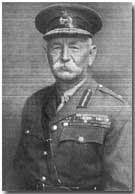Who's Who - Richard Haking
 Richard Cyril Byrne Haking (1862-1945)
served in field command positions in the British army during World War One.
Richard Cyril Byrne Haking (1862-1945)
served in field command positions in the British army during World War One.
A close associate of BEF Commander-in-Chief Sir Douglas Haig, Haking established an unenviable reputation for himself as a "butcher" even while the war was being fought - as opposed to the tag that many commanders have acquired since the close of the conflict.
Haking's pre-war career included a period lecturing as a Professor at the army Staff College. With war declared in August 1914 he was given command of 5th Brigade and travelled with Sir John French - then-Commander-in-Chief - to the Western Front.
Haking almost immediately suffered injury: on 14 September 1914 he received a head wound which required three months of recuperation. This did not impede rapid wartime career progress. His return to duty brought him command of 1st Division from December until September 1915.
He was then handed command of XI Corps with which he served until the end of the war, despite the best efforts of Haig, who attempted (and failed) to secure Haking an army command.
It was while commanding XI Corps that Haking's reputation as a commander willing to wage a war of attrition (pointless to many) first established itself. During the Somme Offensive in July 1916 Haking earned himself the contempt of Australian General Elliott for his decision to launch an attack at Fromelles for no particular purpose.
In November 1917 Haking - and XI Corps - were dispatched to the Italian Front to shore up Italian forces stationed there in the wake of the Caporetto fiasco. Its spell there was brief; within four months XI Corps was back on the Western Front in time for the great German spring push of March 1918.
Stationed near Bethune - familiar ground to XI Corps - Haking's force bore the brunt of an attack by the German Sixth Army. XI Corps performed well in holding the British line and protecting the Channel ports, earning praise from Haig.
A "dogfight" signified air combat at close quarters.
- Did you know?
